Sharlyn J. Lauby's Blog, page 100
April 11, 2019
Change Management: A 3 Step Model
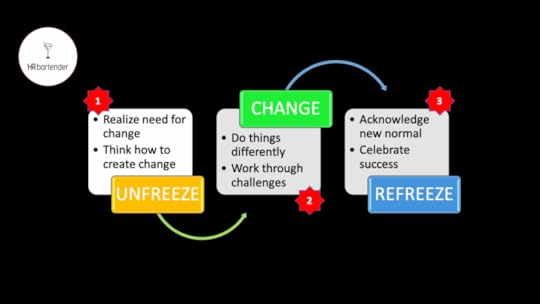 Kurt Lewin Change Model
Kurt Lewin Change ModelEveryone needs to deal with change. Doesn’t matter if it’s a change we’ve decided to make or one that’s forced on us. It also doesn’t matter if it’s small or big. In fact, sometimes it’s the small changes we decide to make ourselves that can be the most difficult.
Regardless of the type of change you’re processing, it’s important to find a change management model that works for you. Personally, I’ve always like Lewin’s model. Kurt Lewin was a psychologist and major contributor in the areas of group dynamics and organizational development. His change model is very easy to remember, which is one of the reasons I like it.
The UNFREEZE stage is where we realize that change is necessary and how it will impact us. We start thinking about how to create change.
During the CHANGE step, we begin to do things differently. We work through the discomfort and challenges of changing our routine.
Finally, in the REFREEZE phase, we acknowledge the new normal. This is also when we can celebrate the success of dealing with the change.
I recently learned another way of thinking about Lewin’s model that I thought was pretty creative. I was facilitating the Society for Human Resource Management (SHRM) seminar on “Organizational Development: Designing Successful Organizational Performance” and we were talking about change interventions. One of the participants said they talk about change in terms of “pencils, pens, and Sharpies”. So, I asked for permission to share their idea here.
PENCILS represent those current processes, policies, or habits that we have. They can also be considered tentative. Things written in pencil can be erased and changed.
PENS are things that become more permanent. It might be an action we plan to have for quite some time, but still realize that at some point in the future it’s going to change.
SHARPIES are for those actions that are going to be around for a very long time. We want everyone to know about this change. Think bold and ingrained in our culture!
I immediately liked this 3-step approach because I could see it being used as part of organizational decision making. For example, the group can agree that an idea is “ready to be PENNED” or we don’t have enough experience with this process to “document it in a SHARPIE”. It also makes for a good visual.
Next time your organization is going through a change management process, think about where they are. Is the group still penciling? Or have they moved to pen? Maybe even Sharpie? It might help to guide the process change in a new and different way.
The post Change Management: A 3 Step Model appeared first on hr bartender.






April 9, 2019
Tell Us Your Favorite Conference Swag [poll] #SHRM19

A couple of weeks ago, I wrote a post with tips for attending the Society for Human Resource Management (SHRM) Annual Conference and Expo. The event is June 23-26, 2019 in Las Vegas. I received a comment on the post asking what kind of swag will be available at the event. Frankly, it’s a great question!
I believe conference swag is important. It’s marketing. When you give someone a logo item, the goal is for them to keep and use it. So, every time they look at it, they see your logo and think of you. That’s the purpose of swag. This means the goal should be to give people swag that they want to keep and/or use.
Honestly, I don’t know what kind of swag exhibitors are planning to give away during the conference. But it did occur to me that instead of finding out what kind of swag exhibitors are considering, let’s tell them what kind of swag conference attendees want to receive. Right? This will tell exhibitors what will attract you to their booth and what you’re prepared to keep and use.
I’ve put together a quick one question poll about conference swag. I got this list from a Facebook group I belong to where I asked about conference swag. The group gave me some awesome feedback about their favorite swag items. Some people even posted pictures of them. Just proving the point that people will keep and remember companies that give out good swag. I’ve put their comments in categories for easy reading and voting.
April 7, 2019
Customer Service In the Age of Full Employment

If you haven’t checked out Steve Boese’s HR Technology blog lately, he ran a great explanation of the latest job openings and labor turnover survey (i.e. JOLTS report). What I liked about his summary was the closing paragraph that talked about the pros and cons to having more open jobs than job seekers.
Obviously, lots of open jobs is great for companies because it could be a sign of increased business growth. It could also be a great thing for job seekers because they can find good career opportunities. Boese also points out the downside to this situation. Companies might feel it’s a negative that they have to raise wages to attract talent. They might end up paying more for a candidate who ultimately doesn’t deliver excellent performance. It could also be a negative for job seekers who make a leap to another employer and later regret the decision.
But there’s another player in the “more job openings than candidates” scenario that organizations need to keep in mind. That’s the customer. In recent months, I’ve become very aware of how not being fully staffed impacts customer service.
I went to have some routine maintenance done on my car. While I was there, the mechanic suggested having some belts replaced. So, I said, “Okay, let’s do it.” The mechanics response? “Oh, I don’t have the staff to do it. Can you come back in a few weeks? I hope to have hired someone by then.” Guess what happened. I found another mechanic to do the work.
Since we moved to Gainesville, I finally found someone I like to style my hair. One day, I get a call from the salon saying that my stylist is pregnant (good news!) but she’s bedridden (not good news for me!). Unfortunately, they only a have a part-time back up stylist and she’s booked for the next three months. They said they would put me on a waiting list. Guess what happened. I found another stylist.
These stories are examples of how being understaffed can impact the customer experience. This doesn’t even touch the other scenario that happens when companies are understaffed and load extra work on the remaining employees, who then get stressed out and cranky because they’re overworked. And they may pass that along to the customer.
I wish I had a magic formula to answer a company’s staffing challenges. Unfortunately, I don’t. But here are five things I do know.
A better employee experience will help keep the employees you have.A better candidate experience could increase the number of people who accept job offers.Candidate sourcing involves more than posting jobs on LinkedIn and Indeed. (No offense to LinkedIn and Indeed).Hiring managers need to plan for jobs to be open longer than a few days or a week. HR departments should start building a freelance network to help fill staffing gaps.
The numbers would lead us to believe that the more job openings than candidates scenario is going to be around for a while. Organizations have to start thinking about how they’re going to take care of the customer while continuing to look for the best talent.
P.S. Hey everyone! Just a quick note from behind the scenes. Mr. Bartender and I are celebrating our anniversary this month. We will be posting content but do have a few things planned so it won’t be on our regular schedule. Thanks for reading and supporting HR Bartender! It means a lot to us.
Image capture by Sharlyn Lauby while exploring EPCOT Center at Walt Disney World
The post Customer Service In the Age of Full Employment appeared first on hr bartender.






April 5, 2019
Worrying Is a Symptom of Employee Stress [infographic]
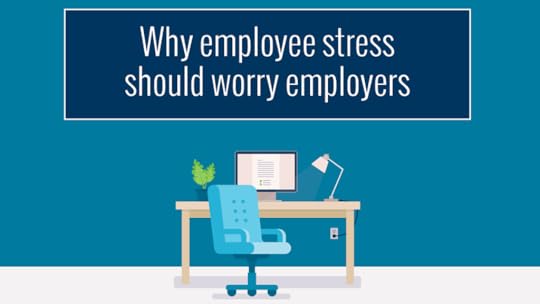
One of the recent trends we’re seeing more conversation about is wellness and well-being. Frankly, it’s about time. I’m happy that organizations are realizing that the old saying “Leave your personal life at the office door.” doesn’t and shouldn’t apply.
Employee stress is a real workplace issue. According to a study from Colonial Life, more than 20 percent of workers spend more than five hours on the clock each week worrying. An additional 50 percent of employees said they lose between one and five hours of work to worry each week.
I don’t have to tell you that when employees spend their time worrying, they’re not being productive. And this costs organizations money. The Bureau of Labor Statistics indicates there are approximately 128.5 million full-time employees earning an average of $21 per hour. This means the cost of employee worry is in the billions.
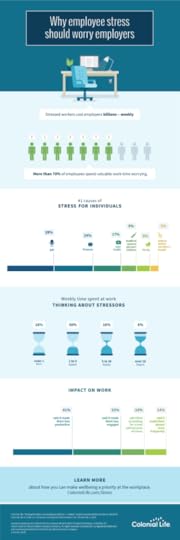
What I did like about this infographic is how worry was separated from the category of stress. I’m not trying to get into a semantics argument, but I do wonder if employees just figure worry is part of being human and don’t take steps to address it before it becomes a bigger issue.
Add to that the number of times an organization feels they’re being transparent or authentic when the reality is their doing “corporate vaguebooking” and adding to an employee’s worries. The infographic says that an employee’s biggest worries come from where? Yep, work.
Bottom-line: organizations and employees need to recognize worry and take steps when necessary to manage it. Some examples include:
Employee Assistance Programs (EAPs)Mindfulness and stress reduction programsFinancial well-being programsFlexible work arrangementsPaid leave programs, such as parental leave and unlimited time off
My guess is many organizations already offer these types of programs either in-house or as part of a well-being program. If organizations do offer these types of programs, it’s important that employees know they exist and how to access them. An employee might be reluctant to stop by HR and ask about them. Don’t simply mention them during orientation and believe that’s enough. Sending regular reminders about all of the benefits available to employees is the right thing to do.
Ultimately, organizations need to create a work environment that supports employees and provides a psychologically safe place for all. That happens through comprehensive benefits programs and supportive management.
The post Worrying Is a Symptom of Employee Stress [infographic] appeared first on hr bartender.






April 2, 2019
How to Get and Keep Buy In From Senior Management
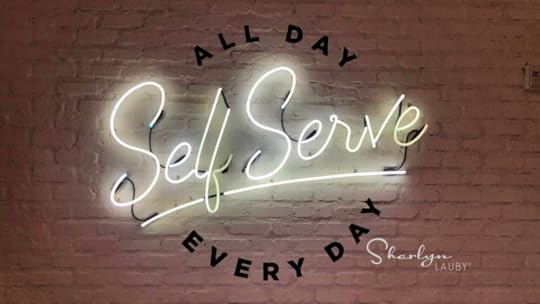
During last year’s HR Technology Conference, one of the speakers said something that I’ve been thinking about for a while. They said that we have to not only get buy in for our ideas and projects but keep it. Totally makes sense. But in reality, how often do we actually do it?
I know many times someone has said to me (or I’ve said to someone), “If you want that project to succeed, you must get buy in from senior management.” The question becomes, during those conversations where we ask someone in senior management to buy into our idea and support us, how often are we outlining what we really mean by “support” including asking what it takes to keep their support? It seems to me that when we’re looking for organizational support, we need to add that step.
The process of garnering organizational buy in might look something like this:
Identify who is the best champion for the project or initiative. Let’s face it some managers are better at this than others. Part of a project’s success is choosing the right champion or sponsor.Ask if they are open to hearing about the project. I believe this is their prerogative. It’s their political capital being put on the line.Pitch the idea using business research and value to the organization. I’d add include the potential obstacles and challenges. Your champion will want to know this anyway.Tell them their role as the champion of the project and get their commitment. This ties into #3. As you’re explaining the project, let them know where you believe they will provide the most value.Ask what needs to be done to keep their commitment. It could be as small as just sending regular reports or meeting with them over coffee occasionally. Or it could be more – like not changing an aspect of the project.
Senior managers get asked to champion projects all the time. In fact, I’ve seen senior managers forget projects they’ve bought-into. I don’t know that it’s really completely their fault. Sometimes project leaders forget to keep them in the loop. Senior managers also have changing priorities. Sometimes the projects they support today aren’t the projects they would support tomorrow (if you know what I mean). This is where having a plan in place to keep senior management support is critical.
The last thing a project leader wants is to start working on a project only to discover that their senior management champion isn’t on board anymore. And this could happen for a variety of reasons that have nothing to do with the project itself. Business goals might shift, budgets and resources could be reallocated, or key staff members needed to focus in a different direction.
By keeping senior management aligned with the project, it’s possible the staff and resources allocated to the project will stay intact. And if a redistribution of resources needs to happen, maybe the senior management champion can keep the project from totally being abandoned. So, keeping buy in might not help in the short-term but it would definitely help in the long-run.
P.S. Speaking of the HR Technology Conference, it’s going to be here before we know it. This year’s conference is October 1 – 4, 2019 in Las Vegas. The event includes their annual “Women in Technology” pre-conference session. A must-attend in my book. Registration details can be found on the HR Technology website.
Image captured by Sharlyn Lauby during the Qualtrics X4 Experience Management Summit in Salt Lake City, UT
The post How to Get and Keep Buy In From Senior Management appeared first on hr bartender.






March 31, 2019
Turnover 2019: Why Employees Leave [survey results]
A few weeks ago, we asked you the question “If you were to start looking for a new job today, what would be the number one reason?” The answer won’t be a surprise.
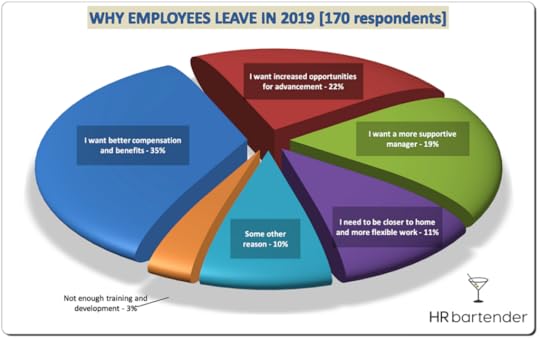
I went back and checked your responses from 2018 and guess what, the turnover reasons rank exactly the same: 1) compensation and benefits, 2) opportunities for advancement, 3) supportive management, and 4) flexible work. The percentages did change.
Compensation and benefits increased 11 points (from 24 percent last year)Opportunities for advancement increased a point (from 21 percent last year)Supportive management decreased a point (from 20 percent in 2018)Flexible work decreased 9 points (from 20 percent in 2018)
Training and development was at the bottom and in the single digits both years. There could be a few reasons for this. I believe employees have really embraced the “own your career” mantra that became so popular during the Great Recession. As a result, training looks different. Training can take the form of MOOCs, books, blogs, webinars, etc. Many of these resources are free.
From the survey results, I also noticed a few more things:
Flexible work is on the rise. I’m going to assume the year over year decrease in flexible work as a reason for turnover coincides with the increase in organizations offering it. I believe that companies are starting to realize with the increase in technology that they can offer this option, it doesn’t cost too much, and employees like it. It also keeps employees from choosing to freelance as a way to have a more flexible lifestyle.
Speaking of freelancing, in this labor market, organizations do have to factor in the gig economy from two angles. First, employees looking for career advancement might choose freelancing as a way to have more control over their careers. And companies that don’t have much to offer in the way of career advancement might need to start looking at freelancers as a way to fill positions. While freelancing could cost more than an hourly employee, companies don’t have to pay benefits. Which leads us to the next point…
Compensation and benefits continue to be an the issue for workers. At some point, organizations will have to create competitive salary packages and benefits. If you want the best talent, it will be necessary. Not surprisingly, I’m starting to see an increasing number of organizations offering signing bonuses.
Finally, management development still needs attention. While training was last on the list, that doesn’t mean organizations can stop doing it. One area that continues to be a cause of turnover is management.
While this survey was only one question and there are many factors that go into turnover, there is one other interesting thing I’d like to point out. I didn’t ask the question “Why did you leave?” I asked the question “Why would you start looking?” They are two different questions. And for the past two years, employees have provided answers that they probably are very comfortable telling the company.
In my experience, employees wouldn’t hesitate to tell me during an exit interview, “I’m making more money.” Or “I’m getting more responsibility.” On the other hand, employees were sometimes reluctant to say, “My boss is a jerk.” Because they didn’t want to burn a bridge. See where I’m going with this? Employees are starting to look for new opportunities based on reasons that they are usually very open about – money and opportunities. Companies have the answer to turnover right in front of them. The question becomes are they going to do something about it?
P.S. Hey everyone! Just a quick note from behind the scenes. Mr. Bartender and I are celebrating our anniversary this month. We will be posting content, but do have a few things planned, so it may not be on our regular schedule. Thanks for reading and supporting HR Bartender! It means a lot to us.
The post Turnover 2019: Why Employees Leave [survey results] appeared first on hr bartender.






March 29, 2019
Employee Experience Must Mirror the Customer Experience
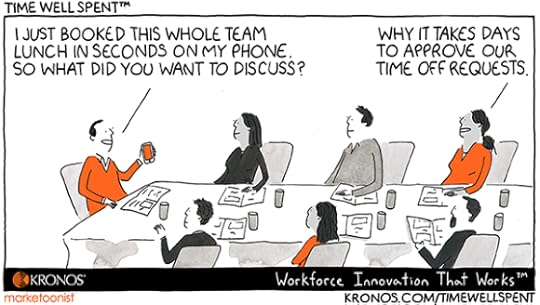
I can’t remember what event I was at, but I remember the comment, “Employees aren’t the same as customers.” It’s true, they aren’t the same. But today’s Time Well Spent from our friends at Kronos reminds us that, on some level, they do expect the same experiences.
Technology is doing some wonderful things for the customer experience. I can make doctor appointments and see my lab results using an app. If my flight is delayed and I miss my connection, the Delta Airlines app will automatically rebook me on the next flight. It’s those little things that make life easier. And if individuals can get that experience in their personal lives, it could drive the employee experience and they will expect it in their work lives.
Use technology strategically. There are times when “going old school” is fun. But there are moments when it demonstrates otherwise. Organizations do not want to appear to be “behind the times”. The goal of technology is to free us up from the mundane so we can focus on things that technology can’t do – like having team conversations or making business decisions.
Technology is definitely a part of the employee experience. Organizations use technology to run their operation. They use technology to source and hire the best talent. Employees expect technology to help them do their jobs. This includes everything from email to artificial intelligence and employee self-service. Employees can see how technology is helping them manage their personal lives and they want to know their employer is going to do the same.
Organizations don’t have to be early adopters for everything. Let me balance the push for organizations to adopt technology with a caveat. Companies do not have to adopt every single new piece of technology that comes to market. It’s perfectly okay to wait a while, see what others are saying, and test drive it before buying. The challenge comes when organizations take years to do that.
While employees and customers are different, they are both essential to our business. And they expect a good employee experience with the company – both in terms of their face-to-face and technological interactions.
The post Employee Experience Must Mirror the Customer Experience appeared first on hr bartender.






March 28, 2019
A Simple Reminder That Words Matter

I ran across this article recently in Business Insider “Teens say they cringe when brands use these 11 outdated slang words – here’s what Gen Z is saying instead”. It’s an interesting list to check out. But not necessarily for the words themselves.
While I’m not a Gen Z, I could see how some words are “in” and others are “out”. I do wonder if the use of some slang is just subjective. For example, I don’t call Mr. Bartender my “bae” even though I am familiar with the term. However, when people ask me why we moved to Gainesville, FL, I do use the word “chill”.
I thought the article was relevant because it shows how the context of the words matter. Case in point: the Business Insider article talks about a Twitter poll from Subway asking users about their favorite bread. Or as they put it “bread bae”. But according to Gen Z, bae is “out” (“bruh” is in). So, guess what? No one answered the poll. Zero responses.
My takeaway from the article was that popular culture terminology changes. It changes with the times and with people. If you’re going to sprinkle some slang into the conversation, it needs to be the right slang. Organizations need to remember this. Both in terms of marketing and candidate and employee communications as well.
If your organization takes pride in writing non-traditional job postings, position descriptions, and company policies, then you’re going to want to stay up on the proper lingo. Because as we see in the Subway example, sometimes in an effort to be rad, hip, or lit, we can fail spectacularly. Far be it from me to tell people how to write but, sometimes it can make sense just to say, “What is your favorite bread?”
Organizations use marketing communications to attract customers, candidates, and employees. Marketing is about words.(It’s about other things too like sounds and images, but you get my point.) If we want people to engage with us, we have to use the right words. Whether that includes the latest slang or more formal semantics.
Image captured by Sharlyn Lauby while exploring the Wynwood Art District in Miami, FL
The post A Simple Reminder That Words Matter appeared first on hr bartender.






March 26, 2019
Employment Brand: 6 Things to Consider

If you didn’t know, HR Bartender runs on a WordPress platform. The reason I’m sharing this is because every year, Mr. Bartender and I go to an event called WordCamp. It’s an educational forum for WordPress users by WordPress users. One of the things I like about WordCamp is it provides an opportunity to hear how people outside of HR think about blogging and some of the creative things they’re doing with their blogs.
Last year’s event was extra interesting because it was our first trip to WordCamp Orlando. In the past, we’ve always attended WordCamp Miami. It’s good to change things up a bit.
During the event, I had the opportunity to hear Sam, a multi-media designer talk about branding. Of course, she was speaking in reference to branding your website or blog, but I thought her comments applied to the conversation we have about employment branding.
When it comes to developing your employment brand, here are my six takeaways from her session:
Determine your brand value. When it comes to identifying your brand, it’s not about being unique. There are lots of companies that do the same thing you do. I learned this in the hotel industry. All hotels have places to sleep. It’s about creating a well-defined value proposition. I must say that I was glad to hear this because I do believe more organizations need to look at their employee value proposition (EVP) when defining their brand.Establish your “voice”.The term voice is often used to refer to your tone. Writers have a voice. Sam encouraged attendees to think of your voice as your beliefs. From an organizational perspective, this could be your values. When you think about your employment brand, what are those things that you will use to connect with your audience?Create a personality. If the company’s voice is their beliefs, then “personality” is how your voice is conveyed. When it comes to employment branding, the goal is to make the company relatable and authentic. That will make the company’s job openings attractive to candidates because people want to work for companies they can relate with.Have a visual identity. Unfortunately, this is often the first thing that companies think about when we talk branding: logos and colors. While having attractive visuals is important, it’s equally important to align the visual elements with the company’s brand value (#1). When a candidate can see your logo and feel the company’s personality without reading a line of copy, then you’ve succeeded.Make a style guide. Once you spent all of this energy creating a look and a voice, now you have to make sure that everyone follows it. Even with a defined employment brand, consistency is the hard part. Hopefully, you don’t have any turnover, but if you do, the brand doesn’t suffer. The guide should include words to use and avoid, fonts and colors, trademarks, and images both in terms of lighting and composition.Review and update regularly. Brands change because brand values change. And that’s a good thing. It’s important to regularly look at our employment brand and decide if it needs some tweaking. This could also be economically advantageous as well. Instead of ignoring the brand then doing a major brand relaunch, consider making smaller tweaks along the way.
Sometimes it’s helpful to listen to people outside of your industry. Because they might offer some ideas you hadn’t considered before. And they might even confirm what you already knew.
Now more than ever, a good employment brand is important. Candidates are looking at your brand and deciding if they want to answer your job openings. Having a stale or outdated brand will keep the organization from attracting talent.
Image captured by Sharlyn Lauby after the WorkHuman Conference in Austin, TX
The post Employment Brand: 6 Things to Consider appeared first on hr bartender.






March 24, 2019
Consider the Implications of Grandfathering Benefits – Ask #HR Bartender

As more organizations look to up their “employee experience” game, I can see the question of grandfathering benefits coming up a little more often. That’s why today’s reader question is so relevant.
Hi! I love your articles and subscribe. Question: Is it normal to grandfather benefits? Our small not-for-profit went through a reorganization where we moved from a CEO and EVP as senior managers to a CEO, CAO (me), CFO, and COO.
I just came across a severance policy that says while the EVP role was eliminated in 2011, ‘Jane Doe’, the former EVP now COO, would continue to receive a severance benefit should she leave. When I asked about it, my CEO said the ‘board’ didn’t want her to lose any benefits that she had in her former position. The other chief officers are not eligible for this benefit. Is this normal? (FYI – The COO also gets other benefits that the other chief officers do not get.)
Obviously, we don’t have all the information here, but I do think we can talk about benefit policies and best practices when changing benefits. To help us understand the nuances involved, I asked our friends at Foley & Lardner, LLP if they would assist and thankfully, they said yes.
Samuel Hoffman is a partner and business lawyer in Foley’s California office. He represents health care providers and government entities in employee benefit matters such as pension plans, compensation, and bonus programs. Please remember that Sam has a regular full-time job as a lawyer and he’s doing this to give back to the profession. His comments should not be construed as legal advice or as pertaining to any specific factual situations. If you have detailed questions, you should address them directly with your friendly neighborhood labor and employment attorney.
Sam, what does it mean when an organization “grandfathers” a benefit?

[Hoffman]To ‘grandfather’ a benefit means that an employee is locked into a certain level of benefit accrual or type of benefit that is not being given to new employees.
For example, an employer might have a severance pay program that provides for a certain level of benefit that it wishes to eliminate as a cost-saving measure, but locks in or ‘grandfathers’ current employees in the current level of severance pay while new employees do not get severance pay or they get it at some lower rate.
The same concept can be applied to other benefits such as vacation, sick leave, health insurance, nonqualified deferred compensation, and qualified retirement benefit programs.
In your experience, is “grandfathering” a common practice? Also, is it something usually found only with senior level positions?
[Hoffman]Grandfathering is a fairly common practice, but it is not the general rule. Grandfathering can and does occur both at the senior level and at the rank-and-file level.
What are the pros/cons associated with “grandfathering” benefits?
[Hoffman] The ‘pros’ of grandfathering an employee or a group of employees in a particular benefit or level of benefit accruals is that you keep valuable employees happy by not having to take something away from them.
The potential ‘cons’ of grandfathering an employee or group of employees in a particular benefit or level of benefit accruals are:
Increasing administrative complexity and the possibility for making mistakes,Creating nondiscrimination testing problems (such as with qualified retirement plans or self-funded health insurance programs) and, Engendering disgruntlement among the newly hired workforce that does not enjoy the benefits that have been grandfathered to the longer service employees.
In my experience the disgruntlement problem is most pronounced when a more junior employee is receiving a benefit that is more valuable than the benefit being received by the employee’s boss.
When should organizations consider “grandfathering” a benefit?
[Hoffman]There are two scenarios when anorganization should consider grandfathering a benefit.
When an employer has a valuable employee who they believe would be disgruntled or perhaps leave if they lost a particular benefit or level of benefit accrual, orWhen the employer has a legal or contractual obligation to continue a certain level of benefits for the employee (such as an executive employment agreement, a collective bargaining agreement or with certain governmental employers that may have constitutional obligation to protect benefit levels for current employees etc.).
Except where grandfathering is legally required, an employer should carefully consider whether the ‘pros’ in employee retention or satisfaction for the employee or employees receiving the grandfathering outweighs the administrative and employee relations ‘cons’ of providing the grandfathered benefits.

Last question. This situation is focused on grandfathering benefits. But I’m curious, are there options that organizations can consider before they grandfather a benefit?
[Hoffman]Yes, before accepting the administrative, possible nondiscrimination testing and employee relations burdens associated with grandfathering a particular level of benefits for an employee or subset of employees, the employer should ask itself whether the valuable employee or employees that the employer wishes to keep happy could be satisfied with some other alternative to grandfathering.
For example, the employer could provide a one-time bonus payment to the employee or an alternative enhancement to other areas of benefits that the employer is prepared to offer to all employees generally. The employer should balance the potential cost savings of a change in benefits and the employee relations issues, both for the valuable continuing employee(s) and the valuable new employees, before embarking upon a commitment to grandfather a particular level of benefits.
I want to extend a huge thanks to Sam for helping us understand more about grandfathering benefits. This is one of those subjects that might appear so simple at face value but is really very complex. If you’re looking to stay on top of labor and employment law issues, be sure to sign up for Foley & Lardner’s electronic newsletter or follow one of their blogs. They’re on my must-read list.
Sam’s comments about weighing the pros and cons of making benefits changes are really spot-on. I totally understand that organizations want to offer the best benefits and compensation packages, but it should be done with careful consideration and a lot of research.
Image captured by Sharlyn Lauby after speaking at the SHRM Annual Conference in New Orleans, LA
The post Consider the Implications of Grandfathering Benefits – Ask #HR Bartender appeared first on hr bartender.






Sharlyn J. Lauby's Blog
- Sharlyn J. Lauby's profile
- 10 followers



